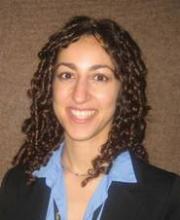SEATTLE – Isolated left ventricular diastolic dysfunction should not be viewed as a reason to withhold ablation therapy in patients with atrial fibrillation and preserved ejection fraction, new data suggest.
Investigators led by Dr. Rosita Zakeri studied a series of 707 patients who were undergoing a first catheter ablation at the Mayo Clinic for symptomatic, drug-refractory atrial fibrillation and who had preserved left ventricular ejection fraction.
Fully 34% had isolated diastolic dysfunction (a left atrial pressure of greater than 15 mm as measured directly by the transseptal approach), according to results reported at the annual meeting of the Heart Failure Society of America.
Patients with isolated diastolic dysfunction had a marginally elevated risk of recurrence of atrial fibrillation at 1 year in a univariate analysis but not after multivariate adjustment. In addition, they derived a similar improvement in quality of life from ablation.
"Although diastolic dysfunction was associated with an increased risk of atrial fibrillation recurrence, in and of itself, it does not appear to be a key arrhythmogenic factor nor strongly related to quality of life at 1 year after ablation," commented Dr. Zakeri, who is a cardiology fellow at the Mayo Clinic in Rochester, Minn.
"Therefore ... the presence of left ventricular diastolic dysfunction should not necessarily discourage the use of catheter ablation for treatment of symptomatic atrial fibrillation in this patient group," she said.
Diastolic dysfunction increases susceptibility to atrial fibrillation, but it is unclear whether it has a continued proarrhythmic effect after ablation, Dr. Zakeri noted.
"We also know that diastolic dysfunction predisposes to heart failure and is one of the hemodynamic hallmarks of heart failure with preserved ejection fraction," she continued. And some patients with atrial fibrillation having diastolic dysfunction may have early heart failure, with the arrhythmia accelerating the severity or presentation of symptoms.
Study results showed that relative to other patients, the patients with isolated diastolic dysfunction had a higher body mass index; had greater prevalences of diabetes, hypertension, and heart failure; were more likely to have nonparoxysmal atrial fibrillation; and had poorer quality of life as assessed with both the Medical Outcomes Study 36-item questionnaire (SF-36) and the Mayo AF-specific Symptom Inventory (MAFSI).
Overall, 21.1% of patients had a recurrence of atrial fibrillation at 1 year, Dr. Zakeri reported. The rate was 25.3% in patients with diastolic dysfunction and 18.9% in patients without it.
The difference corresponded to a marginally elevated risk of recurrence for the group with diastolic dysfunction in unadjusted analyses (odds ratio, 1.45; P = .05), but after adjustment for age, sex, type of atrial fibrillation, and left atrial volume index, there was no significant association.
When patients were stratified by baseline left atrial pressure – less than 12 mm Hg, 12-15 mm Hg, or greater than 15 mm Hg – all three groups had significant improvements at 1 year in scores on the quality of life scales, with no significant difference in the magnitude of improvement between them.
Dr. Zakeri disclosed no relevant conflicts of interest.


